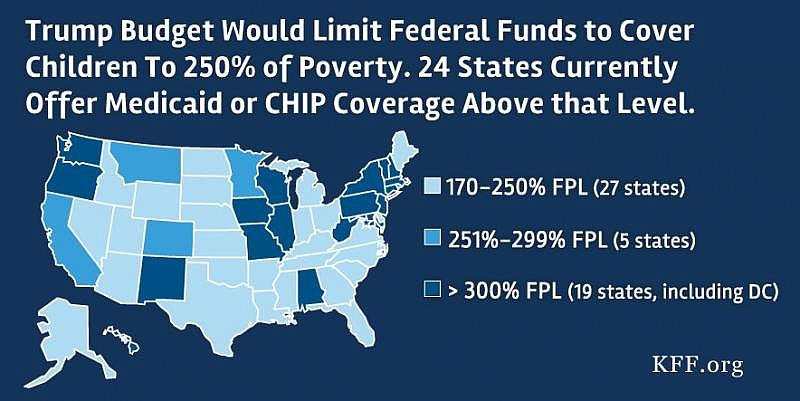What we know about how Trump wants to change health coverage for low-income children
![Photo: Andrew Caballero-Reynolds/Getty Images [Photo: Andrew Caballero-Reynolds/Getty Images]](/sites/default/files/styles/inline_image/public/title_images/GettyImages-687755610.jpg?itok=XbPKXOck)
Photo: Andrew Caballero-Reynolds/Getty Images
Between the release of President Trump’s proposed budget on Tuesday and the highly anticipated CBO score of the House’s health plan on Wednesday, it’s been a blizzard of health policy headlines this week.
The Trump budget proposes massive cuts to safety net programs such as Medicaid and food stamps, both of which benefit tens of millions of families, but it’s worth looking at what the proposal would mean specifically for children’s health programs.
Medicaid and the Children’s Health Insurance Program — which offers coverage to kids in families who earn too much for Medicaid, but not enough to pay for private coverage — are the big players here. Medicaid and the Children’s Health Insurance Program (CHIP) cover nearly 36 million U.S. children, with 8.9 million of those kids enrolled in a CHIP program at some point in 2016.
There’s been ample coverage and confusion this week over Trump’s massive proposed cuts to Medicaid — more than $800 billion over 10 years, according to one estimate from the Times — but the cuts to CHIP are dramatic as well. Here’s a quick recap of what the budget would do:
- Extend CHIP’s funding for two years, through fiscal year 2019. The program is currently set to lose its funding at the end of the current fiscal year unless Congress acts to renew it.
- End the increase in the program’s boosted federal match rate — up to 23 percent for some states — this year. Existing law calls for keeping this higher “CHIP bump” for states through 2019.
- Children ages 6 to 18 in families with incomes from 100 to 133 percent of the federal poverty level were moved from CHIP to Medicaid under existing law. The Trump budget wants states to move these kids back to CHIP, which means families in the 30 states that charge premiums or enrollment fees will have to pay more to keep their kids enrolled.
- Cap the income level for which states can be reimbursed by the federal government at 250 percent of the federal poverty level.
That last change would essentially cut off coverage for children in 24 states that offer public coverage to kids with family incomes above 250 percent. For example, New York sets the income cutoff for CHIP at 400 percent of the federal poverty level, while Alabama sets it at 312 percent. California caps CHIP at 261 percent. That means a lot of kids currently enrolled in public coverage would no longer be eligible. This graphic from the Kaiser Family Foundation shows which states stand to lose the most from the funding cuts:

The Dept. of Health and Human Services couches the changes as a course correction: “These provisions would return the focus of CHIP to the most vulnerable and low-income children.”
That doesn’t sit well with children’s health advocates, many of whom said this week that the budget would unwind decades of progress that has brought the country’s rate of uninsured children down to 5.1 percent, the lowest level on record.
“Essentially the budget proposal would upend Medicaid and CHIP and their decades of success, making a sharp U-turn on the progress the country has made in providing access to health care for children,” wrote Joan Alker, executive director of the Center for Children and Families at Georgetown University, in a blog post blasting the budget.
A host of children’s groups decried the budget, while New York City Mayor Bill de Blasio said “some children will die because of this.”
Binyamin Appelbaum, a Washington correspondent for The New York Times, tweeted, “A big and consistent theme in this budget: Trump is cutting stuff that helps young people and preserving stuff that helps old people.”
And for those who never thought they’d hear the CHIP acronym roll off the tongue of a late-night comedian, Stephen Colbert’s monologue was ready to surprise: “… [T]his budget cuts things like the food stamp program, SNAP, and the children’s health-insurance program CHIP. So he’s cutting SNAP and CHIP, to which America’s children replied, ‘STOP!’ and ‘HELP!’” (Jimmy Kimmel meanwhile, said Trump’s proposal was “basically the Fyre Festival of budgets.”)
While this week’s budget may’ve provoked a wave of despair and angst from children’s health advocates and late-night comedians alike, Vox’s Dylan Matthews offered the helpful reminder that this is very much an aspirational budget for the White House. “The president’s budget is not law, and it is not actually implemented government policy,” Matthews wrote, calling it “an opening volley in a months-long decision-making process.”
But the clock is clearly ticking for the Children’s Health Insurance Program. Earlier this week, ProPublica’s Charlie Ornstein summed up the current state of limbo in a tweet: “CHIP funding ends September 30. What happens next is anybody's guess.”
**
Related Posts
Medicare bill’s passage throws lifeline to children’s health insurance
What do new HHS picks signal for children’s health policy?
Kids' health insurance program faces crucial test this year
Will children’s uninsured rate double if Obamacare is repealed?

